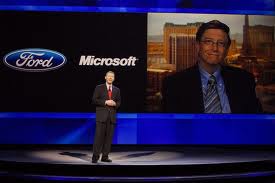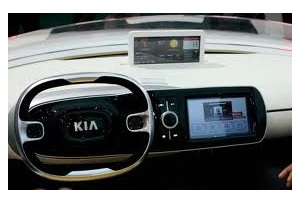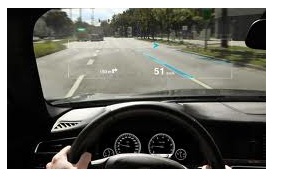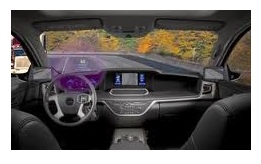 Loading... Please wait...
Loading... Please wait...Categories
Our Newsletter
- Home
- Are We There Yet?
- CES 2012 Automotive technology
CES 2012 Automotive technology
 The Consumer Electronics Show (CES 2012) was full of surprises for the AudioVideo2go.com team this year. More than any other year, car makers showed up to show off their latest and greatest gizmo's. There were so many automotive electronics on display, that at times the CES floor looked like a car show! A walk through this year's exhibitors gave us a glimpse into what driving will be like in the near future.
The Consumer Electronics Show (CES 2012) was full of surprises for the AudioVideo2go.com team this year. More than any other year, car makers showed up to show off their latest and greatest gizmo's. There were so many automotive electronics on display, that at times the CES floor looked like a car show! A walk through this year's exhibitors gave us a glimpse into what driving will be like in the near future.
While most of us are still waiting for our jet packs and flying cars, auto makers are concentrating on getting our automobiles to be as smart as our phones. The biggest theme we found at this years show as the need to stay connected. As a younger generation, accustomed to constant contact, grows to become car owners, they are demanding an ever more connected car. Automakers have responded by creating on-board infotainment systems that rival the smartest of phones and tablets. These systems allow drivers to update their Facebook status, make dinner reservations, and access voice-activated navigation (among other things).
 Ford pioneered the connected car with its Sync system, which it unveiled at CES in 2007. At that time, most car makers ignored Ford's move into the electronics realm of CES and believed it to be a fad. Consumers, it was believed, wanted more horse power, not computing power. Times have changed, and 2012 has been a year of enlightenment for the automakers. These days younger consumers are just as concerned with connectivity and car-tech as they are with fuel economy and performance. Automakers have taken notice and CES 2012, six out of the 10 major car makers have exhibitsto display their newest infotainment tech.
Ford pioneered the connected car with its Sync system, which it unveiled at CES in 2007. At that time, most car makers ignored Ford's move into the electronics realm of CES and believed it to be a fad. Consumers, it was believed, wanted more horse power, not computing power. Times have changed, and 2012 has been a year of enlightenment for the automakers. These days younger consumers are just as concerned with connectivity and car-tech as they are with fuel economy and performance. Automakers have taken notice and CES 2012, six out of the 10 major car makers have exhibitsto display their newest infotainment tech.
Automotive development typically advances at a glacial pace. Cars have to last 10 years or more, not a short two year smart-phone contract period. But, engineers have re-doubled their efforts and the pace of automotive connectivity advancement this year is astounding. Most of the system's we saw connect to the internet via Wi-Fi or 3G to provide a wide variety of services that go beyond just updating your Facebook status and asking for directions. The cars of the Internet age will be able to automatically notify authorities when there has been crash (much like OnStar already does), link to Internet radio stations (such as Pandora and NPR.com) and offer you a selection of applications that you can download to expand your vehicle's capabilities. As an example, GM's OnStar released an application in 2011 to help you lock/unlock your doors, check the maintenance schedule of your vehicle, and even sound the horn if you've lost your car in a large parking lot. New for 2012, OnStar said it would open its proprietary system to independent app makers so they can create free or low cost applications for OnStar enabled cars (of which there are 6 million on the road today). With access to OnStar’s systems, mobile apps will be able to look up navigation or other information on a user's phone, and then beam the info to the car’s navigation system.
Kia has also released several apps for it's second generation smart radio, the UVO 2. In  addition to all the things you already expect from a radio, such as MP3 playback, bluetooth, and navigation, there’s also a smartphone app. The application helps owners track their car’s diagnostics and actually explain, in plain English, what that pesky check engine light means. And if you lose your car in the mall parking lot the UVO 2 has you covered - it remembers the GPS coordinates of where you parked and will guide you back to your car through your smartphone. Parents will love the feature that allows them to set up speed limits, curfews and driving distance limits. If a teen drives too far, too fast, or too late parents will be notified so they'll be able to take action at the appropriate time.
addition to all the things you already expect from a radio, such as MP3 playback, bluetooth, and navigation, there’s also a smartphone app. The application helps owners track their car’s diagnostics and actually explain, in plain English, what that pesky check engine light means. And if you lose your car in the mall parking lot the UVO 2 has you covered - it remembers the GPS coordinates of where you parked and will guide you back to your car through your smartphone. Parents will love the feature that allows them to set up speed limits, curfews and driving distance limits. If a teen drives too far, too fast, or too late parents will be notified so they'll be able to take action at the appropriate time.
 Not to be out-done, Garmin has also been working on it's own in-car technologies in the hopes of licensing them to automakers The Garmin K2 system is designed to be a vehicles complete infotainment solution and it takes the place of a car's entire instrument cluster, radio, navigation and climate control. The instrument panel is one elongated, customizable screen that stretches from the driver side to the passenger side. Drivers can customize every aspect of K2 through an online portal. Once a driver sets up a profile and selects what features are wanted (such as calendar, to-do lists, favorite music streams, information streams and so on), and which gauges to show, the profile is saved no matter what car is being driven.
Not to be out-done, Garmin has also been working on it's own in-car technologies in the hopes of licensing them to automakers The Garmin K2 system is designed to be a vehicles complete infotainment solution and it takes the place of a car's entire instrument cluster, radio, navigation and climate control. The instrument panel is one elongated, customizable screen that stretches from the driver side to the passenger side. Drivers can customize every aspect of K2 through an online portal. Once a driver sets up a profile and selects what features are wanted (such as calendar, to-do lists, favorite music streams, information streams and so on), and which gauges to show, the profile is saved no matter what car is being driven.
Audi has taken a slightly different approach to connectivity. While future Audi models will be able to have applications similar to Kia and GM, Audi wanted to stress connecting the driver to the drive. Features such as an augmented reality view of the road provide the driver with important information about the driving environment. For example, instead of placing navigation directions on a separate screen, which the driver has to look at, the augmented reality display will superimpose the navigational arrows and distances right on the actual view of the road. This is done through heads-up-technology (HUD) and can have several driving benefits; Augmented reality can be used to provide night vision, or enhanced vision in difficult to see situations. It can highlight dangers on the road, such as animals or other obstacles a driver may easily miss. Audi is also installing a new system to help drivers deal with the most boring part of driving - traffic jams. With the push of a button, Audi's new "Traffic Jam Assistant" will take over the drive by steering, accelerating and braking autonomously at speeds up to 37mph. Drivers will be relieved of stressful congested driving situations so that when they get back to highway speeds they'll be refreshed and attentive to road conditions.
driver with important information about the driving environment. For example, instead of placing navigation directions on a separate screen, which the driver has to look at, the augmented reality display will superimpose the navigational arrows and distances right on the actual view of the road. This is done through heads-up-technology (HUD) and can have several driving benefits; Augmented reality can be used to provide night vision, or enhanced vision in difficult to see situations. It can highlight dangers on the road, such as animals or other obstacles a driver may easily miss. Audi is also installing a new system to help drivers deal with the most boring part of driving - traffic jams. With the push of a button, Audi's new "Traffic Jam Assistant" will take over the drive by steering, accelerating and braking autonomously at speeds up to 37mph. Drivers will be relieved of stressful congested driving situations so that when they get back to highway speeds they'll be refreshed and attentive to road conditions.
This deluge of information has caused some worries, however. With so much information about your drive, such as where you are located (GPS), who you are (Facebook), and how you are driving all being shared on the Internet, how private will our Sunday drives be? This is a very similar privacy dilemma that social networks and credit card companies faced. While automakers have certainly learned from the mistakes of other industries, it's likely that they may make some missteps along the way. In the mean time, it is at least nice to know that a driver can opt-out of any of the tech-options they don't want to use.
An additional worry that permeated discussions on automotive connectivity was the danger of driver distraction. Auto makers insist that the new technology will reduce distractions by eliminating the need to use gadgets, such as smartphones and GPS units, while driving. Trying to answer a phone call, or look for directions on a phone while driving at highway speeds is certainly much more dangerous than being able to simply ask your car to do it for you. While state laws banning phone use in cars has done little to reduce distracted driving accidents, a change in the way technology can be accessed may be a better safeguard than legislation. For example, Delphi's contribution to CES 2012 was a system to ensure that drivers did not use vehicle-tech to their detriment. A Delphi system tracking a drivers face warns the driver when their eyes leave the road for more than a few moments. If the driver ignores the warning, the system automatically dims the infotainment screen.  The Delphi system also keeps track of road conditions, distances between cars, and other driving factors. It then limits the function of certain vehicle accessories to help keep the driver from being distracted. If it's below freezing and the driver is in dense traffic, the system may stop updating new Tweets or text messages for example. Garmin has also taken a similar, and perhaps simpler approach; as long as the driver's hands are on the wheel, the car's infotainment system is accessible by the passenger or through voice command. If the driver's hands are removed from the wheel while the car is in motion, the system won't allow inputs.
The Delphi system also keeps track of road conditions, distances between cars, and other driving factors. It then limits the function of certain vehicle accessories to help keep the driver from being distracted. If it's below freezing and the driver is in dense traffic, the system may stop updating new Tweets or text messages for example. Garmin has also taken a similar, and perhaps simpler approach; as long as the driver's hands are on the wheel, the car's infotainment system is accessible by the passenger or through voice command. If the driver's hands are removed from the wheel while the car is in motion, the system won't allow inputs.
While we didn't see any hover boards, or flying cars, we did see enough to make us feel like kids in a candy store. If technology can do for the car what it did for the mobile phone, we're in for a very exciting 2012! If only they could figure out a way to make the self-washing car, that also folded laundry - that would be a feature we would all buy! What kind of features do you hope to see in the near future? How do you feel about the ever increasing number of techie options available in cars? Let us know!

